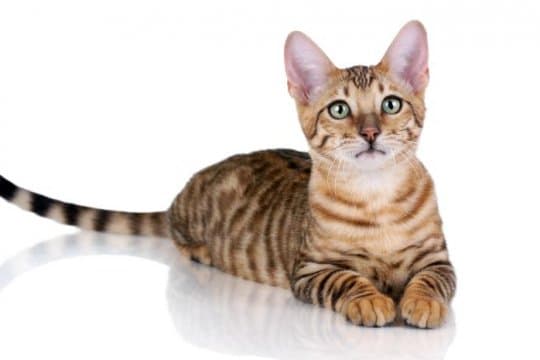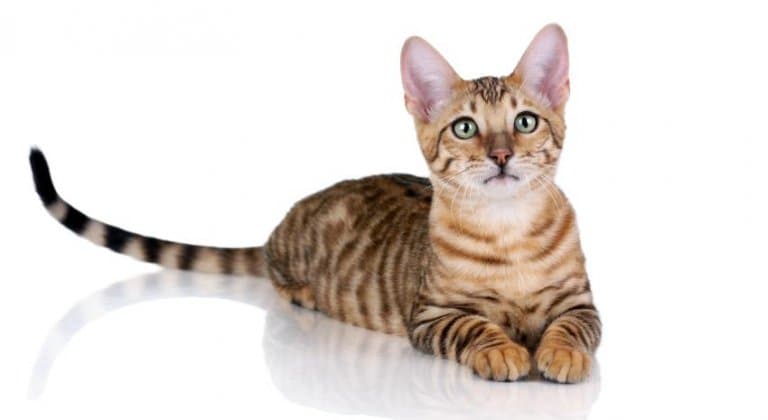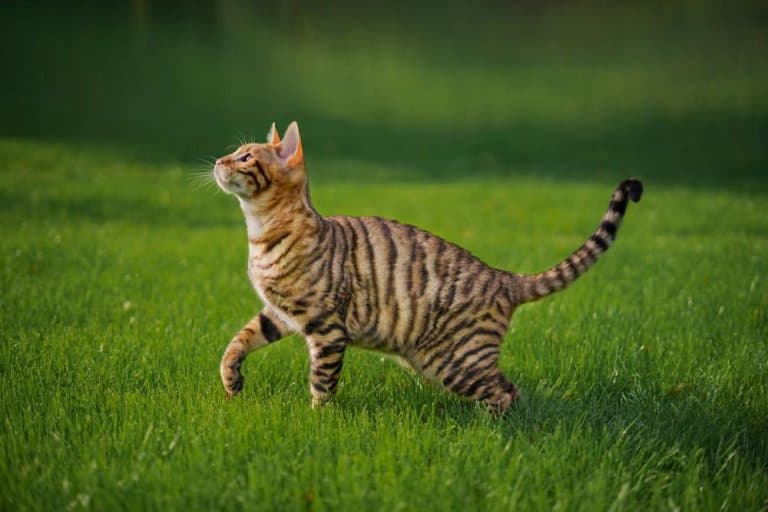
toyger
Active, affectionate, playful, intelligent
Overview
Origin
United States
Life Span
12-15 years
Height
8"- 10"
Weight
7-15 pounds
Group
Medium-sized short-haired
Price
$1200 - $3000
History

Toyger cats are the results of breeding Bengal cats with domestic shorthair breeds with tabby markings. Developed by breeder Judy Sugden of California’s EEYAA cattery in the late 1980s, the Toyger cat is meant to display tigerlike features including a deep orange to red-brown coat with prominent stripes throughout and a wild looking face to match.
The breed got its start when Sugden noticed that her cat Millwood Sharp Shooter had circular facial markings similar to a tiger's. With the help of a domestic shorthair tabby cat named Scrapmetal and a Bengal cat named Millwood Rumpled Spotskin, the Toyger breeding program was off to a good start.
In 1993, another founding member was added to the lineup. This time it was a street cat from Kashmir, India. The cat, named Jammu Blu, had spotted markings between his ears instead of tabby stripes. Approximately 40 other cats, many of them on pedigreed domestic shorthairs with striped coats, were selected for use as foundation stock.
1993 was a banner year for the Toyger cat, as two more breeders, Alice McKee and Anthony Hutcherson joined such then in working toward official recognition. That same year, The International Cat Association (TICA) accepted the Toyger cat breed for registration only. In 2007, TICA granted the Toyger championship status. Even so, it remains one of the world's rarest cat breeds.
Care

Nutrition
The Toyger cat has no special nutritional needs. At the same time, a quality diet is extremely important for good health and longevity. If you're not feeding fresh food, we recommend choosing a brand that names real meat or fish as the number one ingredient.
Grooming
The Toyger cat does have a very short coat, however the fur's texture is thick and plush. These kitties benefit from regular brushing – at least once or twice per week. While Toyger cats are perfectly capable of grooming themselves, brushing helps cut back on shedding and reduces the risk of hairballs.
Exercise
Toygers tend to be highly active. Besides climbing cat towers, jumping from one piece of furniture to the next, and running through the house at lightning speed, these kitties enjoy playing with toys, particularly when their people are involved.
Health
Toyger cats have a reputation for good health, however they have inherited some known issues from their Bengal ancestors. Some individuals are at an elevated risk for developing cataracts, and others may develop hypertrophic cardiomyopathy or heart murmurs.
Breed Standard

Body
The body should be larger and longer than that of a typical cat when viewed in proportion to the rest of the cat’s anatomy. The forequarters should display ample strength, and the shoulders may rise up to interrupt the cat’s topline. The chest should be broad and deep, amplifying the impression of a strong, robust feline. The cat’s shape should exhibit rolling contours, and should not appear blocky. Females may appear more delicate and less athletic than males.
Head
The Toyger cat’s head should be of medium size, and should be long, broad, and deep. From the side, it should appear as a half-hexagon, defined by angle change points at the chin, nose, forehead, and rear portion of the skull. The chin should be strong, wide, and deep; the muzzle well-defined, and the nose muscular, long, rounded, and widened toward the end to a width at least as wide as the space between the eyes. From the front, the face should form an elongated upside-down heart shape that extends from the forehead to the well-rounded whisker pads.
Eyes
The Toyger cat’s eyes should be of small to medium size, and should display a circular shape with gentle hooding at the upper inside.
Ears
The ears should be rounded, and should be set as much to the sides of the head as on the top. Lynx tipping is considered undesirable.
Color
Brown tabby is the only permissible color. The tabby markings should be very dark, against a richly colored rufused ground that may appear reddish to orange. The tabby markings should be modified, forming branched or broken vertical stripes that create a random pattern. Facial markings should exhibit a circular pattern, and a scattering of gold “glitter” should cover the coat.
Coat
The coat should be short, with markings perhaps slightly longer than the ground color. Jowl ruffs and areas of longer fur at the temples are acceptable. The Toyger’s fur should be thick and luxurious, with a soft, plush feel.
Tail
The Toyger’s tail should be very long and rope-like, with a rounded tip.
Legs & Paws
The legs should be of medium length, so that the space between the ground and the cat’s body appears equal to the torso’s depth. The feet should be large, with long toes that exhibit prominent knuckles.